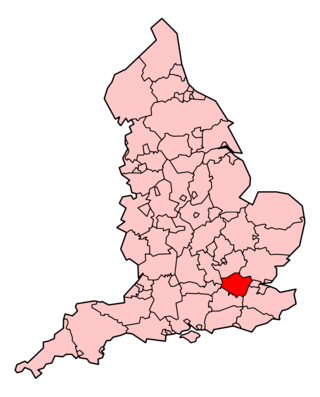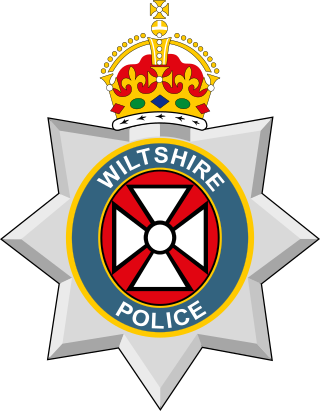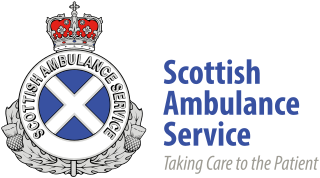
London's Air Ambulance Charity is a registered charity that operates a helicopter emergency medical service (HEMS) dedicated to responding to serious trauma emergencies in and around London. Using a helicopter from 08:00 to sunset and rapid response vehicles by night, the service performs advanced medical interventions at the scene of the incident in life-threatening, time-critical situations.

The London Ambulance Service NHS Trust (LAS) is an NHS trust responsible for operating ambulances and answering and responding to urgent and emergency medical situations within the London region of England. The service responds to 999 phone calls across the region, and 111 phone calls from certain parts, providing triage and advice to enable an appropriate level of response.

Wiltshire Police, formerly known as Wiltshire Constabulary, is the territorial police force responsible for policing the county of Wiltshire in South West England.

The Scottish Ambulance Service is part of NHS Scotland, which serves all of Scotland's population. The Scottish Ambulance Service is governed by a special health board and is funded directly by the Health and Social Care Directorates of the Scottish Government.

The South East Coast Ambulance Service NHS Foundation Trust (SECAmb) is the NHS ambulance services trust for south-eastern England, covering Kent, Surrey, West Sussex and East Sussex. It also covers a part of north-eastern Hampshire around Aldershot, Farnborough, Fleet and Yateley. The service was made an NHS foundation trust on 1 March 2011.

The South Western Ambulance Service NHS Foundation Trust (SWASFT) is the organisation responsible for providing ambulance services for the National Health Service (NHS) across South West England. It serves the council areas of Bath and North East Somerset, Bournemouth, Christchurch and Poole Council, Bristol, Cornwall, Devon, Dorset, Gloucestershire, North Somerset, Plymouth, Isles of Scilly, Somerset, South Gloucestershire, Swindon, Torbay and Wiltshire.

Yorkshire Ambulance Service NHS Trust ("YAS") is the NHS ambulance service covering most of Yorkshire in England. It is one of ten NHS Ambulance Trusts providing England with emergency medical services as part of the National Health Service it receives direct government funding for its role.

The South Central Ambulance Service NHS Foundation Trust (SCAS) is the ambulance service for the counties of Berkshire, Buckinghamshire, Oxfordshire and most of Hampshire. It is a foundation trust of the National Health Service, and one of ten NHS ambulance trusts in England. As of August 2022, SCAS is currently rated Inadequate by the CQC following multiple failings within the trust. SCAS is the only Ambulance Service in England to have received this rating.

The East of England Ambulance Service NHS Trust (EEAST) is an NHS trust responsible for providing National Health Service (NHS) ambulance services in the counties of Bedfordshire, Cambridgeshire, Essex, Hertfordshire, Norfolk and Suffolk, in the East of England region. These consist of approximately 6.2 million people across an area of 7,500 square miles (19,000 km2).

The West Midlands Ambulance Service University NHS Foundation Trust (WMAS) is responsible for providing NHS ambulance services within the West Midlands region of England. It is one of ten ambulance trusts providing England with emergency medical services, and is part of the National Health Service.

Emergency medical services in the United Kingdom provide emergency care to people with acute illness or injury and are predominantly provided free at the point of use by the four National Health Services (NHS) of England, Scotland, Wales, and Northern Ireland. Emergency care including ambulance and emergency department treatment is only free to UK residents and a charge may be made to those not entitled to free NHS care.

The British Association for Immediate Care (BASICS) is an organisation which has the stated aim to encourage and aid the formation and extension of immediate care schemes. The British Association for Immediate Care was founded as a charity in 1977 and combines bringing people together who have an interest in pre-hospital immediate care with supporting and promoting regional and local immediate care schemes across the UK.

Freewheelers Emergency Voluntary Service (EVS) is a blood bike charity based in South West England. Founded in Weston-super-Mare in 1990, it is funded by public donations and staffed by unpaid volunteers.

The East Anglian Air Ambulance (EAAA) is an air ambulance providing Helicopter Emergency Medical Services (HEMS) across the English counties of Norfolk, Suffolk, Cambridgeshire and Bedfordshire. The appeal to fund the service was launched in the summer of 2000 by top jockey Frankie Dettori, who had been a casualty in a serious plane crash a couple of months earlier. When flying commenced in January 2001, the service was initially available only one day a week. The East Anglian Air Ambulance operates two helicopters, 365 days a year, from its bases at Cambridge Airport and Norwich Airport, covering over 5,000 square miles (13,000 km2) and a population of approximately 3.5 million.
Wiltshire Emergency Services was a collaboration in the 1990s and early 2000s of the emergency services in Wiltshire, England, namely Wiltshire Police, Great Western Ambulance Service and Wiltshire Fire and Rescue Service. The primary element of this collaboration was the joint control centre in Devizes, which is now operated by the Wiltshire Police only. After both Wiltshire Fire and Rescue Service and the Great Western Ambulance Service ceased to exist following mergers with other services, the dedicated Wiltshire Emergency Services collaboration was abandoned in favour of collaborations between services across wider geographical areas.

Blackberry Hill Hospital is an NHS psychiatric hospital in Fishponds, Bristol, England, specialising in forensic mental health services, operated by the Avon and Wiltshire Mental Health Partnership NHS Trust. The hospital also offers drug and alcohol rehabilitation inpatient services, and is the base for a number of community mental health teams.
Avon and Wiltshire Mental Health Partnership NHS Trust (AWP) is an NHS mental health trust providing adult mental health and related services in Wiltshire and the former county of Avon, an area centred on Bristol.
Healthcare in the city of Bristol, England and the surrounding area is largely provided by the National Health Service (NHS). Until July 2022, this was provided through the Bristol, North Somerset and South Gloucestershire clinical commissioning group. Facilities include a large teaching hospital – Bristol Royal Infirmary – which offers nationally commissioned specialist cardiac, cancer and children's services from its city-centre campus to patients in the southwest of England and beyond.
Healthcare in Somerset, England was the responsibility of three clinical commissioning groups (CCGs) until July 2022. These covered the ceremonial county of Somerset, which comprises the areas governed by the three unitary authorities of Somerset, North Somerset and Bath and North East Somerset.

The Great Western Air Ambulance Charity (GWAAC) is a charity air ambulance service in South West England. It operates for the relief of sickness and injury, with a specialist paramedic in critical care and a critical care doctor, providing response by helicopter or car between the hours of 7:00 am and 1:00 am, 365 days a year. The service covers Bristol, North Somerset, Bath and North East Somerset, South Gloucestershire, Gloucestershire, and surrounding areas.

















